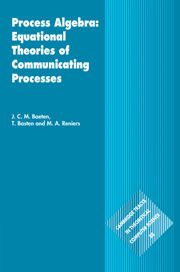Book contents
- Frontmatter
- Contents
- Foreword
- Foreword
- Foreword
- Preface
- 1 Process algebra
- 2 Preliminaries
- 3 Transition systems
- 4 Basic process theory
- 5 Recursion
- 6 Sequential processes
- 7 Parallel and communicating processes
- 8 Abstraction
- 9 Timing
- 10 Data and states
- 11 Features
- 12 Semantics
- Bibliography
- Index of Symbols and Notations
- Index of Authors
- Index of Subjects
Foreword
Published online by Cambridge University Press: 05 July 2014
- Frontmatter
- Contents
- Foreword
- Foreword
- Foreword
- Preface
- 1 Process algebra
- 2 Preliminaries
- 3 Transition systems
- 4 Basic process theory
- 5 Recursion
- 6 Sequential processes
- 7 Parallel and communicating processes
- 8 Abstraction
- 9 Timing
- 10 Data and states
- 11 Features
- 12 Semantics
- Bibliography
- Index of Symbols and Notations
- Index of Authors
- Index of Subjects
Summary
Nowadays, much of what is still called ‘computing’ involves the behavior of composite systems whose members interact continually with their environment. A better word is ‘informatics’, because we are concerned not just with calculation, but rather with autonomous agents that interact with – or inform – one another. This interactivity bursts the bounds of the sequential calculation that still dominates many programming languages. Does it enjoy a theory as firm and complete as the theory of sequential computation? Not yet, but we are getting there.
What is an informatic process? The answer must involve phenomena foreign to sequential calculation. For example can an informatic system, with many interacting components, achieve deterministic behavior? If it can, that is a special case; non-determinism is the norm, not the exception. Does a probability distribution, perhaps based upon the uncertainty of timing, replace determinism? Again, how exactly do these components interact; do they send each other messages, like email, to be picked up when convenient? – or is each interaction a kind of synchronized handshake?
Over the last few decades many models for interactive behavior have been proposed. This book is the fruit of 25 years of experience with an algebraic approach, in which the constructors by which an informatic system is assembled are characterized by their algebraic properties. The characteristics are temporal, in the same way that sequential processes are temporal; they are also spatial, describing how agents are interconnected. And their marriage is complex.
- Type
- Chapter
- Information
- Publisher: Cambridge University PressPrint publication year: 2009



